Notes towards a suicide letter
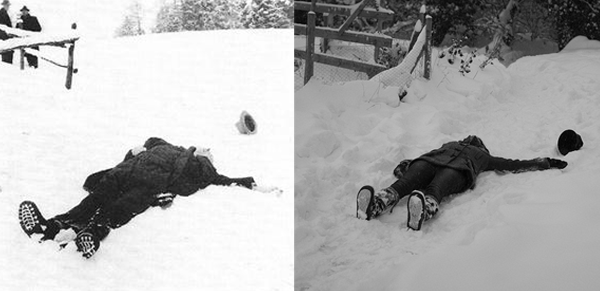
On December 25, 1956, Robert Walser died from a heart attack during a walk near the asylum where he had spent the last 23 years of his life. Cezanne is said to have died (1906) in similar fashion, during a walk, but no pictures had been taken, a painter’s ironic affront to photography perhaps. There are various angles from which a handful of pictures of Walser’s death were taken, each version collated into an incident. On December 2, 2010, a girl took a picture of herself as Walser, only the exclamation mark formed by her arm and hat were too close to each other. Things tend to roll farther when they are dropped rather than placed. Walser abruptly gave up writing in 1933, checking himself into a mental asylum, where he remained for the rest of his life. As an extension of his genius, “I am not here to write,” he said, “but to be mad.” Duchamp similarly disowned visual art — degrading it as “retinal,” a glimmer for the mere receiving lens of the eye — to move towards math and chess. These of course, are not suicides, no more than Suicide (2008), which may be read as author Edouard Levé’s (who killed himself in 2007) glorified suicide letter. He was also a painter and photographer, burning all his canvases in his early career to make mental room for photography, a photographer’s non-ironic affront to painting. Here’s the deal though: they are both rectangular windows of conceit, fake life in a box. The second-person “you” in Suicide eerily takes on the semblance of instruction, and you find yourself slowly disappearing with each page, as if the toner was running out of ink.
Back to a future
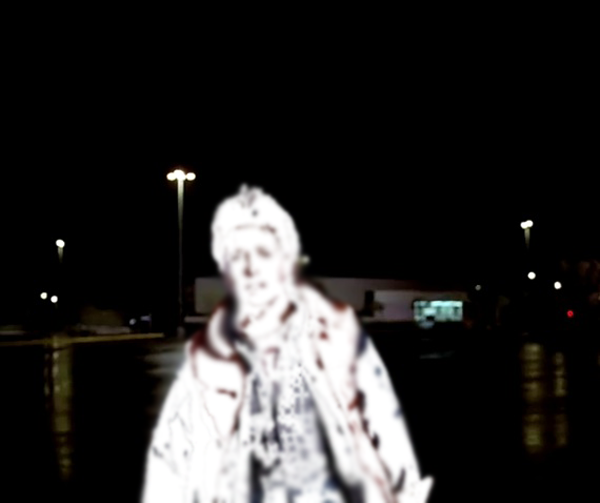
Scat-stacking shitty yesterdays together I go back in time, on my therapist’s chair, retrace particular events in my childhood, and open my eyes to the blurry wet room, depleted and calm. He’s been leaning in, elbow dents on his knees, eyes maybe a little wet too. I am trying to correct the past with my personal fucks capacitor. Lived a dumb tv movie life, or better yet when movies from the past wound up on tv; went to college at an English lit class lived a dumb book life, or better yet when those books wound up as movies; moved to a city for a dumb metrosexual life, or better yet someone tell me what that even means. Maybe, the past unforgiving, you moved from one city to another, kept exchanging cities, trading in your tokens at casino life for better cards, fairer dice, the unsightly decorative carpet under your feet, heads locked in vices in rooms you couldn’t see. And if gambling is our metaphor, I’ll be the old guy at the slot machine, the repetitive injury of his right arm pumping away at some statistical god, awaiting the golden shower of coins which will sound as a tambourine, hey play a song for me, I’m not sleepy and there is no place I’m going to. In 1985, with that preceding Orwellian-slash-Van Halenian year neatly tucked behind us, one Marty McFly disappears from a suburban parking lot at night.
Reincarnate hard
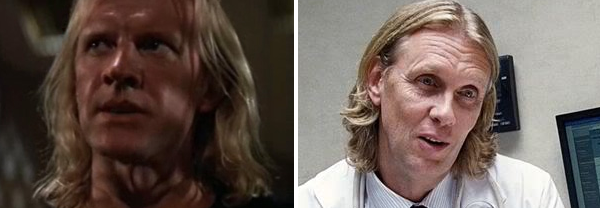
In Funny People (dir. Apatow, 2009), Adam Sandler, since diagnosed with cancer, teases his oncologist about looking like Karl, the blond villain in Die Hard (1988) who rises from the dead at the end of the film for a final shot at John McClane (Bruce Willis), only to be shot dead by the black cop, played by the guy who ended up playing Urkel’s neighbor. (I’ll spare you my theory on the subconscious racism of how all “good cops” are black, as if such casting were some progressive affront to the more common implicit stereotype.) It is sadly wonderful how all of you know what I’m talking about, these names and faces closer than our own cousins — that there are semi-dense clusters of cells in our brains dedicated to remembering these things, that we are somewhat thwarted by them, yet continuously rewarded. In Hollywood’s game, people can be anything, and Apatow is aware of the pleasure we derive in getting the reference, the erratic yet embedded memory of Karl, as Bruce Willis and John McClane are equally distilled with meaning in this regard. (“Where you try to kill Bruce Willis” is Sandler’s punchline.) The question is did the script call for an actor who looked like Die Hard’s Karl, or was the script cleverly revised, ad libbed even, once they noticed the similarity? The answer is less important than its instigator. Karl since has risen from the dead twice, an unlikely Jesus, save the perfect Aryan hair.
Greatest freak out ever
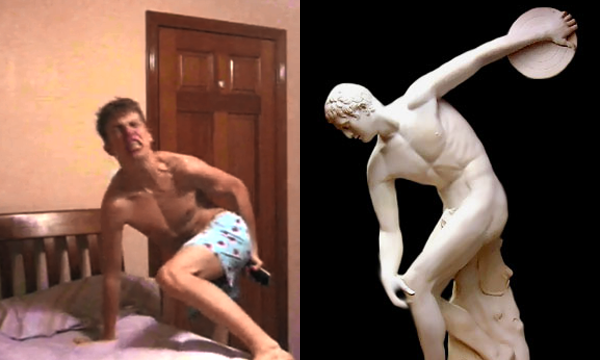
In 2009, a young man named Stephen became very upset when his mother cancelled his World of Warcraft account. Should you deride a child for being so invested in the sub-parallel world of the internet, I ask what you are doing here. His brother Jack recorded what ensued inside the former’s room, which most of you have seen. It is entropic, cathartic, and harrowing. At one point, Stephen attempts to insert a remote control “up his ass,” which is less a comment about shitty television than a residual impulse from one’s anal stage (1-3 yrs) in psycho-sexual development. I wonder what shows Stephen watches at night, the distance from the world he feels as gathered by the talking faces. This contributor will note his sculpturally toned young body; the contracted neck muscles of taut anger; the stately plant of his right arm; and the eager arch, while not exactly graceful, of his hip, as he invites the inadament object into this being. Myron’s “Discobolus” (450 BC), of grace and harmony of the human form, has been since critiqued by both art historians and athletes as a rather inefficient way to throw something — but art has never been about distance, but rather, nearness. To touch a marble body is to feel cold unflinching flesh, the timeless detached heart of mere form. To get inside a person, you may as well be a remote.
Metamorphoses

One morning Michael Richards woke up to discover he had been transformed into a giant racist. Saying “nigger” is the opposite of suicide, horrible for one’s career. He freaked out and kept repeating the n-word in a comedy club, caught on tape, the way the thousands of rapes and lynchings never were. Technology’s greatest capacity is its inadvertence to do some good. One morning I woke up to discover that I didn’t want to read any more of Kafka’s diaries, just too depressing I guess. To Milena Jesenská he once wrote, of his love for her, “love is to me that you are the knife which I turn within myself,” which — if I were a girl — would’ve done wonders at the bar, instead of that vodka martini and BMW car keys (or Roland Barthes, depending on the girl you’re after) rested ever gently on the counter. Love is to you the butter knife that spreads it on you, which is less of a compliment than a call to have your cholesterol checked. It’s a beautiful moment when, deep into a book you don’t enjoy, you finally stop. The most honest blurb is not finishing. As the make-up artists applied “baked” on Kramer’s face, I wonder if it reminded them of Blackface ☻. When white people want darker skin for socioeconomically convoluted reasons, I feel so happy ☺.
Say something, say something, anything
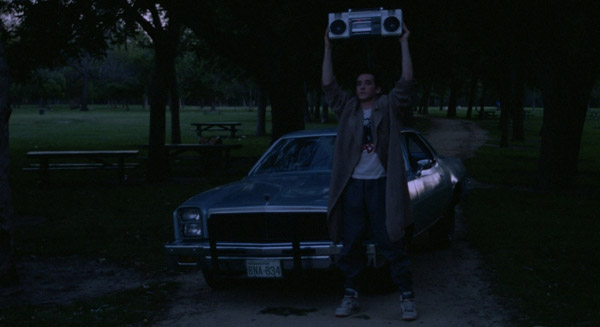
II. Say Anything
I’ve never seen Say Anything, released in 1989 when I was 13, fell into the gap of people who were too young to see it in real time, and not interested enough to see it as the cultural imperative it kind of became for the coming of age romantic allegory. Sometimes I feel like I should just see the movie and get it over with, but I’m afraid I wouldn’t love it as much as I do now, like the idea of what you think is inside something is better, more inviolate, than the actual thing. You know how actors ruin the characters in a book made into a movie? Or how the movie ruins the book? Or how the book’s execution ruins its conception? Art, really, is a bag of failure.
So I have not seen the scene where John Cusack holds the boom box for the girl, perhaps to play a song? I know it’s about a guy who likes a girl, and he plays a song for her because maybe he can’t play guitar and sing, or maybe the song was playing during an intimate moment. Yah that’s probably it. I know these things because I have lived in this world the same way you have, and together we understand these things — the kissing, the songs, the I love and hate yous, which brings us to dawn, after the 2:00 am text, having been up all night, somewhere in the middle of this world, a broken google map URL, a night gripped by tendrils of want, which felt, this middle, like the edge.
Best friends forever
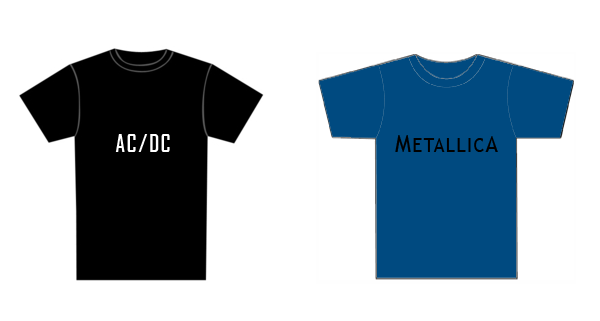
These two shirts were worn by Beavis and Butthead between 1993 and 1997, though one may presume that our friends still wore their shirts in our collective consciousness following the show’s end — through spin-offs King of the Hill and Daria, via ones Tom Anderson and Daria Morgendorffer, respectively — to this very day, we among the kids who unwittingly grew into near adults, the thick riffs of the invoked bands still sawing away at our heads, some distant drum roll ready to lift our arms in the tethered rapture of a limb. Watching MTV into the night, I always wished I had someone to share my feelings about the death of masculinity, or rather just feelings in general. The odd effeminate misogyny and the perverse coital nuances of their guitar holding were misguided directions to manhood, so I had no choice but to look towards my father, who picked up dog feces on the lawn with his bare hands. I told him to wear gloves and he called me a girl.
Hoe Fiction Works

1
The house of fiction has many windows, but only two or three doors. As for the door to the laundry room, only my wife knows that one. But enough about white male jokes. I quickly got lost in my Barthian funhouse and called my editor, who told me to say Flaubert every other page. The hoes of friction, besides a pun, implicates literature’s true calling, to quench the muse of hoes, those handjob sirens motioning like a rap video, if such videos where directed by Renoir.


